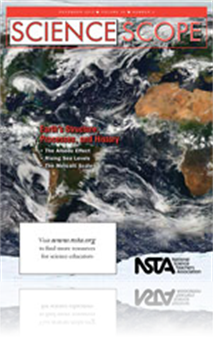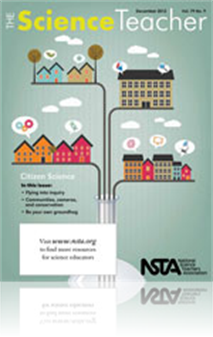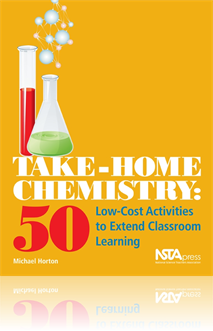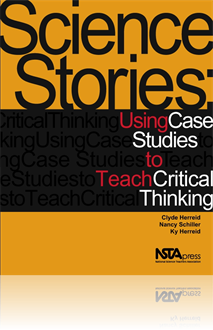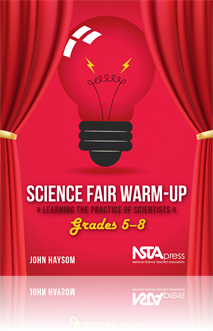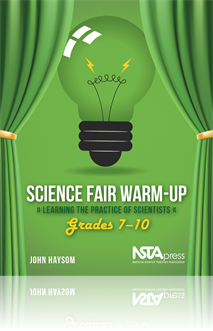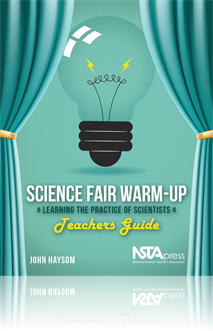All Resources
Journal Article
Everyday Engineering: Toying Around With Wind Ups
This column provides an inside look at the marvels of engineering in everyday life. In this issue the authors use wind-up toys to introduce students to how gears interact....
Journal Article
The New Teacher's Toolbox: Defining Your Homework Stance (Part 1)
This column shares tips for teachers just beginning their career. This month’s issue discusses different approaches to homework....
Journal Article
Exploring the Science Framework
This article discusses what it means for students to be mathematically proficient in the context of science and makes connections in math with the Common Core State Standards....
Journal Article
Explorations of Our Frozen Planet
Learn more about the cryosphere and the consequences of global warming....
Journal Article
Exploring the Science Framework
This article discusses what it means for students to be mathematically proficient in the context of science and makes connections in math with the Common Core State Standards....
Journal Article
Tried and True: Inside the Earth: Using Cookie Dough to Teach the Layers of the Earth
This column provides classic demonstrations and experiments with a new twist. This month’s issue discusses using cookie dough to assess what students know about the layers of the Earth....
Journal Article
Teaching Through Trade Books: Bridges and Skyscrapers
This column includes activities inspired by children’s literature. This month’s issue talks about the secrets behind engineering marvels and discovering that the materials you choose to build something are just as important as how you build it....
Journal Article
Investigating Future Climate Scenarios
Identify which locations are most at risk for a global warming–induced rise in sea level....
Journal Article
Safety First: Modeling Safety in Clay Use
This column shares safety information for your classroom. This month’s issue discusses the types of clay and when to use each type....
Journal Article
Project Citizen: Promoting Action-Oriented Citizen Science in the Classroom
In this article the authors present the multidisciplinary Project Citizen approach to teaching and learning science and engaging students in action-oriented citizen science....
Book Chapter
Balancing Chemical Equations Simulation
In this activity, students will use paper cutouts to simulate chemical reactions and balancing products and reactants...
Book Chapter
In this activity, students will measure the expansion and contraction of a balloon as it is cooled and heated....
Book Chapter
In this activity, students calculate how many moles of salt and sugar are contained in packets....
eBook
Science Stories: Using Case Studies to Teach Critical Thinking (e-book)
Stories give life and substance to scientific methods and provide an inside look at scientists in action. Case studies deepen scientific understanding, sharpen critical-thinking skills, and help students see how science relates to their lives. In Sci...
eBook
Science Fair Warm-Up, Grades 5–8: Learning the Practice of Scientists (e-book)
Even science fair enthusiasts may dread grappling with these two questions: 1. How can you organize many middle school students doing many different projects at the same time? 2. How can you help students while giving them the freedom of choice a...
eBook
Science Fair Warm-Up, Grades 7–10: Learning the Practice of Scientists (e-book)
Even science fair enthusiasts may dread grappling with these two questions: 1. How can you organize many middle and high school students doing many different projects at the same time? 2. How can you help students while giving them the freedom of...
eBook
Science Fair Warm-Up, Grades 8–12: Learning the Practice of Scientists (e-book)
Even science fair enthusiasts may dread grappling with these two questions: 1. How can you organize many high school students doing many different projects at the same time? 2. How can you help students while giving them the freedom of choice and...
eBook
Science Fair Warm-Up, Teachers Guide: Learning the Practice of Scientists (e-book)
Even science fair enthusiasts may dread grappling with these two questions: 1. How can you organize many students doing many different projects at the same time? 2. How can you help students while giving them the freedom of choice and independenc...
NSTA Press Book
Scientific Argumentation in Biology: 30 Classroom Activities
“Individuals who are proficient in science should be able to understand the language of science and participate in scientific practices, such as inquiry and argumentation. Empirical research, however, indicates that many students do not develop thi...
By Victor Sampson, Sharon Schleigh
NSTA Press Book
Science Fair Warm-Up, Teachers Guide: Learning the Practice of Scientists
Even science fair enthusiasts may dread grappling with these two questions: 1. How can you organize many students doing many different projects at the same time? 2. How can you help students while giving them the freedom of choice and independenc...
By John Haysom
Book Chapter
Classifying Birds in the United States
The purpose of the activity, in this chapter, is to help students understand (1) what counts as a species in the field of biology, (2) some of the various definitions for species that can be used by biologists, and (3) the challenges associated with ...
Book Chapter
Characteristics of Viruses (Characteristics of Life)
The purpose of this activity is to help students understand how biologists distinguish between living and nonliving objects. It can also be used to introduce cell theory. This activity will help students learn how to engage in practices such as const...
Book Chapter
Spontaneous Generation (Cell Theory)
The purpose of this activity, in this chapter, is to help students understand that all life on Earth arises only through the reproduction of preexisting life and not from nonliving materials. This “life from life” principle is called biogenesis....
Book Chapter
Movement of Molecules In or Out of Cells (Osmosis and Diffusion)
The purpose of this activity is to help students understand the process of osmosis and to understand how a cell membrane acts as a selective barrier. This activity also helps students learn how to engage in practices such as using planning and carryi...
Book Chapter
Liver And Hydrogen Peroxide (Chemical Reactions and Catalysts)
The purpose of this activity is to help students understand that most cell functions involve chemical reactions and many reactions (including decomposition and synthesis) are made possible by enzymes. This activity also helps students learn how to en...
Book Chapter
Cell Size And Diffusion (Diffusion)
The purpose of this activity is to help students understand passive transport in cells (i.e., diffusion and osmosis) and how the size of a cell can impact the time it takes for important molecules to diffuse through a cell. This activity also helps s...
Book Chapter
Environmental Influence on Genotypes and Phenotypes (Genetics)
The purpose of this activity is to help students understand Mendelian genetics and how the environment can influence the phenotypes of organisms. This activity also helps students learn how to engage in practices such as using mathematics and computa...



